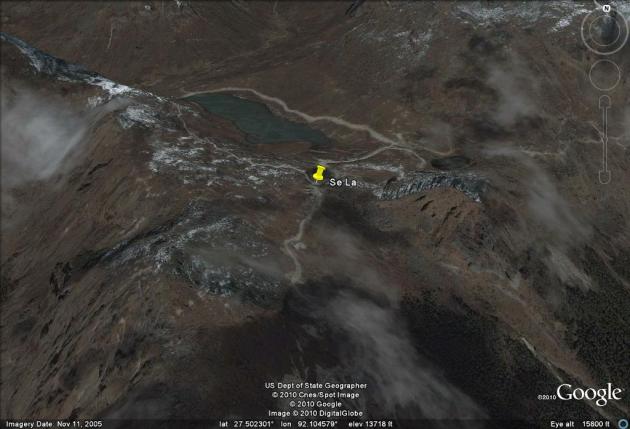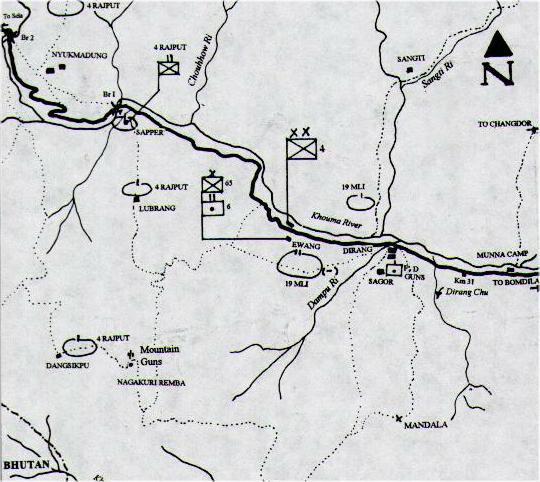The
Namka Chu river flows towards east from the Tri-junction point on
Bhutan-India-Tibet borders, along the India-Tibet border, till it
reaches the eastern end of the Thagla ridge, to confluence with
Nyamjang river. From this point, this river now flowing southwards,
crosses India-Tibet border and flows into India all along the Bhutan
border to reach villages of Lumpo and Shakti and eventually meets
east-west flowing Gomkang Chu river first and later the Tawang Chu
river. Shakti village mentioned here is located roughly to west of
district town of Tawang. The main road from Shakti village to
Tawang, passes through Lum La pass. As we saw earlier, Chinese army
or PLA soldiers crossed McMahon line international border on 23rd
October 1962 and with rapid advances reached Lumpo first and then
Shakti village.
Tawang
town is considered as one of the most important towns of NEFA or
Arunachal Pradesh. In October 1962, a number of army units such as
4th
Artillery, 4th
Infantry and 22nd Mountain had their divisional headquarters located
at Tawang. The nearest pass on India-Tibet border at Bum La was
located about 26 Km from Tawang. The second important border pass at
Tutling La was at some distance to the east of Bum La. The entire
plan for defense of Tawang was made on an assumption that Chinese
advance would take place through one of these passes and accordingly
Indian troops were well dug in solid defensive positions all along
the roads leading to these passes. However, when news of rapid
Chinese advance through Nyamjang river basin reached the garrison at
Tawang, the Generals in command faced a real dilemma as they had no
ready plans to defend Tawang town.
There
was only one route available from Tawang town to nearest rail head at
Tezpur in Indian state of Asaam. From Tezpur, this road could take
only light army trucks (1 Ton capacity) up to town of Jang, via Bomdi
La, Dirang-Se La route and after crossing the bridge on Tawang Chu
river. After Jang, all materials had to be transported by horses or
mules. Defenders of Tawang knew that there was an alternate track
available from Chinese border east of Tawang, which directly
connected to Jang town. If Chinese troops would advance along this
route, they would reach Tawang Chu river at Jang with least
difficulty and destroy the only bridge on this river. In this
eventuality the entire garrison at Tawang and all units stationed
north of Tawang would be cut off from only supply route available
from Asaam.
The
garrison in Tawang was commanded by Maj. General Niranjan Prasad.
Considering the situation in Tawang and in consultation with his
superior, Lieutenant General L.P. Singh, he took a decision, which
is considered as the most controversial decision of this 31 days war.
According to this decision taken on 23rd
October, all troops stationed in Tawang and in the north were asked
to withdraw, south of the bridge on Tawang Chu at Jang. Many
officers posted in Tawang did not agree with this decision as
garrison in Tawang was well provided and stocked and they could have
defended Tawang for a long time. Besides, even in case of the bridge
on Tawang Chu destroyed by Chinese, it could be rebuilt by Indians
as right up to that bridge the road from Assam was motorable.
Indian
forces retreated south of Tawang Chu by 6 PM on 24th
October and the bridge on Tawang Chu was demolished. This decision to
retreat, created tremendous demoralizing effect on Indian troops and
enabled the Chinese to capture Tawang town and entire region north of
it without firing a single bullet. With this sudden change in the
situation in their favour, rapidly advancing PLA troupes stopped in
their tracks for next 3 weeks to consolidate their positions.
The
situation in the Indian positions south of Tawang Chu river was that
of utmost chaos and confusion with no one knowing exactly the chain
of command and the real situation. New units were continuously
arriving from Assam. In many cases, their equipments and arms were
being sent somewhere else. The decisions regarding where these
troops should position themselves were continuously changed as
proper chain of command did not exist. There was a great shortage of
trucks every where. The troops were transported to new locations but
their gear was left behind. A detailed description of this state of
chaos is given in the official report published by the Government of
India and makes a very sad reading.
After
retreating from Tawang, it was decided first to defend the Se La
pass. This decision was suddenly reversed and it was now decided to
build main Indian defensive positions on the bank of Dirang Chu river
near the town of Dirang. Defensive positions however were also built
along Se La – Jang route. After waiting for 3 weeks, Chinese
resumed their attack in three columns. Besides a column moving along
Se La route, two columns attacked Indian positions from two flanks.
It is impossible to narrate what happened on 17th
and 18th
of November as the situation in the Indian camps was of ultimate
chaos. Army commanders were giving orders, which were often
contradicting. A review carried out after the war came out with a
startling revelation that on these two days no one actually knew,
what was really happening. After noting the overall retreat of the
Indian army from all positions, the officer in command of NEFA
operations, Maj. General B.M.Kaul gave orders for retreat and re
grouping of Indian forces to south of Bomdi La.
Only
silver lining on the dark clouds in this situation was the fight that
defending Indian troops gave to advancing Chinese. Indian troops
fought bravely and gallantly without bothering least about their
lives. Unfortunately, because of the lack of co-ordination, method or
order in the command chain, this great fighting effort by Indian
troops, did not produce any harmonious and lethal impact on the
enemy. In this state of confusion, a battle was fought near “Lagyala
Gompa' Buddhist monastery near town of Dirang. This battle, just
like the battle of Rezang La in Ladakh, can be called mother of all
battles in Arunachal Pradesh.
Here,
Lt. Col. Bramhanand Avashthi and his men defended their positions
till the last man and the last bullet. When the Chinese eventually
overran the Indian position, Lt.Col. Avasthi and his 126 men and
officers wear lying dead at their battle stations along with 200 dead
bodies of Chinese invaders. After the battle, victorious Chinese had
buried all dead bodies of Indian soldiers along with their dead but
at a separate place. After the war was over, the dead bodies of
Indian soldiers were exhumed and later cremated. The local people
consider this battle ground now as a revered place and pay their
respects by carrying out 'Pooja' here regularly. A detailed
description of the Dirang battle can be read on this link.
Lt. Col. Bramhanand Avasthi, The tiger of Dirang
Indian
troops now in retreat to south of Bomdi La were a totally
demoralized and depressed lot. Instead of advancing by Dirang-Bomdi
La route, Chinese outflanked Indian defenses along this route by
rapidly advancing along an unused track. Indian forces were totally
surprised and Chinese forces were able to capture Bomdi La with least
effort. Two tanks were sent by army HQ to defend Bomdi La. However
they proved to be quite ineffective against Chinese anti tank
weapons.
On
21st
November 1962, Indian troops started arriving on their foot at the foot
hills of this hilly region in an extremely demoralized, worn out and
haggard condition. The official Government report says that even to
watch these troops, known for their gallantry and bravery was an
extremely painful sight. On 21st
November itself, Beijing radio announced unilateral cease fire on all
fronts and Chinese advance came to an end.
This
story of Indian retreat and defeat in the Kameng sector of NEFA was
repeated in Subansiri, Siang and Lohit sectors also. In Kameng
sector, it can be said that there was a border dispute about Thagla
ridge between India and China. In other sectors there was never any
dispute about the border. Yet the attacks came, just proving the
fact that Chinese had planned all this operation very carefully and
well in advance. It was no spur of moment decision on part of Chinese
leadership. What they probably never expected was the speed of
collapse of Indian defenses and the debacle that happened.
After recalling the account of pathetic Indian defeat and retreat in Kameng sector of Arunachal Pradesh, a question lingers in my mind. Who really defeated the mighty Indian army known for its bravery and gallantry here? I do not have answers and leave the question for the readers.
(To be
concluded)
23rd
October 2012






Great article. A minor typo needs correction in following sentence. The name Lt Gen LP Singh should be LP Sen.
ReplyDelete"The garrison in Tawang was commanded by Maj. General Niranjan Prasad. Considering the situation in Tawang and in consultation with his superior, Lieutenant General L.P. Singh, he took a decision, which is considered as the most controversial decision of this 31 days war."